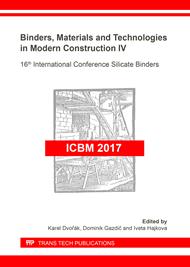[1]
S. Donskoy, Russian must use the USSR effective ways of recycling 2016 Information bulletin of Federal Agency of Ecology. 3 (2016).
Google Scholar
[2]
S.P. Oleynik, Building waste for reconstruction. Internet magazine «Waste and sources» Vol 3. 2 (2016) 1-10.
Google Scholar
[3]
S.О. Alimkulov, U.I. Almatova, I.B. Egamberdiev, Waste is global problem. Modern ways of waste recycling. Young scientist. 21(2014) 66–70.
Google Scholar
[4]
D.U. Nuzhdina, The specifics automobile tires recycling in Russia and in foreign countries. Architecture and transport systems: problems, perspectives, inovation: Proceeding of international conference, Omsk, 2016., 574–578 p.
Google Scholar
[5]
А.К. Pokrovskiy, N Ennan, Ecology and recycling of automobile tires. Reporter of transports. 11(2004) 37–38.
Google Scholar
[6]
Е.D. Pavlovskaya, Е.S. Tatarinova, Т.А. Mihaylichenko, The automobile tires and general rubber goods recycling. Science and youth: problems, searching and solving. Proceeding of Russian conference for students and young scientists, Novokuznetsk, 2016., 236–238 p.
Google Scholar
[7]
А.А. Deriglazov, Recycling of automobile tires in the fine, The young scientist. 17 (2014). 310–313.
Google Scholar
[8]
Giedrius Girskas, Digita Nagrockiene, Crushed rubber waste impact of concrete basic properties, Construction and Building Materials, 140 (2017) 36–42.
DOI: 10.1016/j.conbuildmat.2017.02.107
Google Scholar
[9]
G.V. Repina, N.А. Chemyakina, Е.G. Tarskaya-Lapteva, Chrysotile-cement building materials. Field of utilization, АМB, Ekaterinburg, 2009., 152 p.
Google Scholar
[10]
S.М. Neiman, А.I. Vezentsev, S.V. Kashanskiy, About safety of asbestos-cement materials, RIF «Stroimaterialy», Moscow, 2006., 64 p.
Google Scholar
[11]
A.M. Rashad, A comprehensive overview about recycling rubber as fine aggregate replacement in traditional cementitious materials, International Journal of Sustainable Built Environment. 5 (2016) 46–82.
DOI: 10.1016/j.ijsbe.2015.11.003
Google Scholar
[12]
I. Mohammadi, H. Khabbaz, K. Vessalas, In-depth assessment of crumb rubber concrete (CRC) prepared by watersoaking treatment method for rigid pavements, Construction and Building Materials, 71 (2014) 456–471.
DOI: 10.1016/j.conbuildmat.2014.08.085
Google Scholar
[13]
N. Segre, I. Joekes, Use of tire rubber particles as addition to cement paste, Cement and Concrete Research, 30 (2000) 1421–1425.
DOI: 10.1016/s0008-8846(00)00373-2
Google Scholar
[14]
M.M. Reda Taha, M. Asce, A.S. El-Dieb, M.A. Abd ElWahab, M.E. Abdel-Hameed, Mechanical, fracture, and microstructural investigations of rubber concrete, Journal of Materials in Civil Engineering, 20 (2008) 640–649.
DOI: 10.1061/(asce)0899-1561(2008)20:10(640)
Google Scholar
[15]
D. Pedro, J. De Brito, R. Veiga, Mortars made with fine granulate from shredded tires, Journal of Materials in Civil Engineering. 25(2013) 519–529.
DOI: 10.1061/(asce)mt.1943-5533.0000606
Google Scholar


